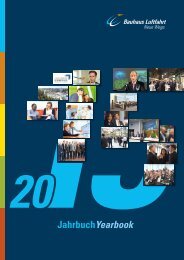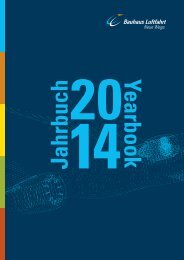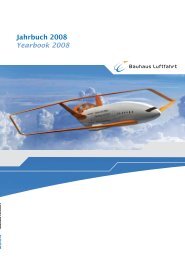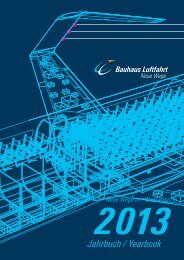Bauhaus Luftfahrt Jahrbuch 2019
- No tags were found...
You also want an ePaper? Increase the reach of your titles
YUMPU automatically turns print PDFs into web optimized ePapers that Google loves.
57
Potenzial der Flugzeugoberflächen als Wärmesenke bei Hot Day Take-Off
(i) Verhältnis von Wärmesenkenkapazität zu benötigter Kühlleistung (C Q ) eines vollelektrischen Flugzeuges für verschiedene Oberflächentemperaturen (T surf )
(ii) Erforderliche T surf , um C Q = 1 für verschiedene Hybridisierungsgrade (H P ) zu erreichen
Heat sink potential
of aircraft surfaces
at hot day take-off
(i) Ratio of heat sink capacity to
required heat load (C Q ) of a fully
electric aircraft for different
surface temperatures (T surf )
(ii) Required T surf to achieve C Q = 1
for different degrees of
hybridisation (H P )
C Q [–]
1.75
1.50
1.25
1.00
0.75
0.50
0.25
T surf [K] = 320
T surf [K] = 360
T surf [K] = 400
(i)
T surf [K]
400
390
380
370
360
350
340
H p [–] = 1.00
H p [–] = 0.75
H p [–] = 0.50
(ii)
0 2 4
0 2 4
MTOW [kg] x10 5
MTOW [kg] x10 5
Theoretischer Einfluss der Wandheizung/
-kühlung auf die Grenzschicht einer glatten
ebenen Platte
Dichte (ρ), Haftreibungskoeffizient (C f ), Haftreibungswiderstandskraft (D f )
und Grenzschichtdicke von 99 % (δ) an einer beheizten (T h ) im Vergleich zu
einer unbeheizten (T u ) Wand; gültig für Re x = 10 6 –10 8
Theoretical impact of wall
heating/cooling on a smooth flat
plate boundary layer
Density (ρ), skin friction coefficient (C f ), skin friction drag force (D f ),
and boundary layer 99 % thickness (δ) near a heated (T h ) compared
to an unheated (T u ) wall; valid for Re x = 10 6 –10 8
∆ [%]
50
40
30
20
10
0
-10
-20
-30
-40
ρ
C f
D f
δ
-50
0.5 1.0
1.5
2.0
T h
T u














